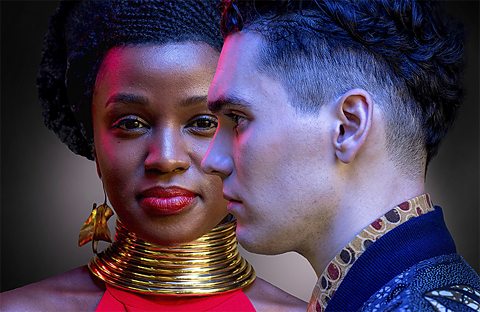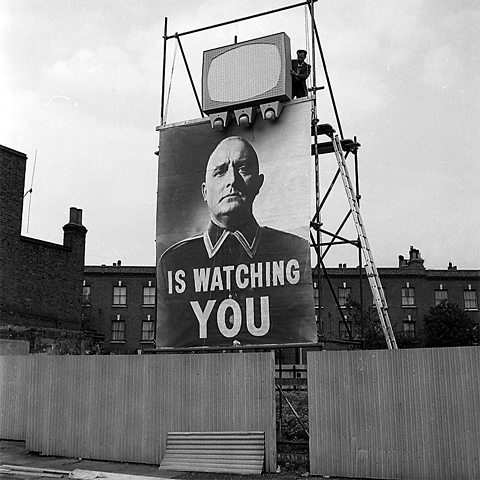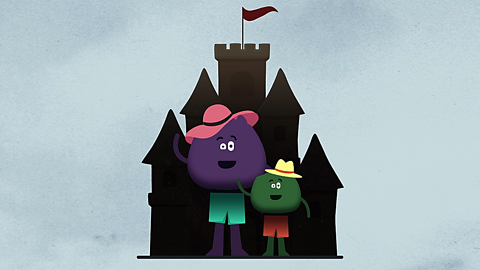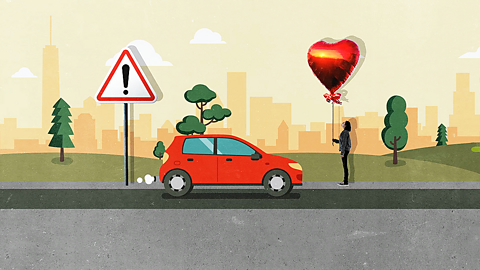Did you know?
The word contextThe set of circumstances that surround a particular event or situation. is derived from the Latin words con (meaning ‘together’) and texere (meaning ‘to weave’).
Introduction to context in fiction texts
Key learning points
- Context is the circumstances in which a text is written and also the circumstances in which the text is read.
- Context can play an important role in understanding fictional texts.
- Historical, social, political context can influence writers and be reflected in what they write.
- Events and experiences from the writer’s own life will also affect a text.
- A writer may also be influenced by literary context – what other writers are producing and what style of literature is popular at the time.
Video about context in fiction
Video about how the context of a writer can influence what they write
All written work is influenced by what’s going on in real-life, in the world around the writer – that’s the writer’s context. Unless, perhaps the writer lives in a dark cave.
Even then, the writer would be influenced by the silence and the bleak, empty nothingness. Or perhaps the possibility of what might be lurking in the darkness would capture their imagination…
Writers are influenced by their social context: the way people lived and what they believed when the fiction was written and set.
Mary Shelley wrote Frankenstein many years before electricity was introduced into people's homes. Electricity must have seemed magical in a society where people couldn’t simply turn on an electric light. So using the invention to bring a creature to life was remarkable, in that context.
Writers are influenced by their historical context: what was happening in the world when the fiction was written and set.
Shakespeare wrote Macbeth to flatter a real-life Scottish King, who became the King of England and a patron of Shakespeare’s company. The play dramatizes an episode of Scottish history, in which there was a real king called Macbeth.
Writers are influenced by their political context: what was happening politically in the world when the fiction was written and set.
For example, Orwell’s Nineteen-Eighty Four describes a world where 'Big Brother' - the government - watched citizens on the street. This will have seemed very different, to contemporary, post-war readers in 1949 compared to a reader living today, familiar with modern surveillance and CCTV.
Writers are influenced by their biographical context. For example, living in a cave, a writer might not know about the latest technology, but they might be able to describe the dark, cold cave life like nobody else. Stories are influenced by the writer’s own life experiences.
And a writer might write in a particular genre, for example a ghost story or a romance. The literary context is the way that other stories or poems in the same genre might influence a text.
What is context?
All writers are the product of their context, in other words their surroundings can influence their writing.
Context can be broken up into a variety of areas:
- Social context – What society would have known, understood and expected at the time of writing the text.
- Political context – A writer can be influenced by political situations, different types of ruling governments etc.
- Historical context – Historical events the writer has experienced or been influenced by.
- Literary context – What other literature has influenced the writer?
- Personal context - The events from a writer’s own life also provide a useful context to understand a fictional text.
It is also important to consider the reader’s context. How do your experiences and interests shape your interpretation of a text?

Read the following extract from a student’s essay. What type of context are they discussing?
Shakespeare did not invent the story of Romeo and Juliet. It’s likely that he was influenced by a long narrative poem called The Tragicall Historye of Romeus and Juliet, which was written in 1562 by the English poet Arthur Brooke. Brooke in turn was influenced by a French translation of a tale that was written by the Italian writer Matteo Bandello.
A. A Society’s context
B. Reader’s context
C. Political context
D. Literary context
The answer is D. Literary context. They are referring to other texts that have influenced the writer, Shakespeare.
Social context

Social context is often the impact of events and situations in society. This could include themes such as race.
Malorie Blackman wrote Noughts & Crosses, a novel which discusses the racial tensions in society. Malorie Blackman is a black woman living and writing in the UK and her experience and observations of racism in her lifetime have influenced her Noughts & Crosses series. She has used her context to explore racism.
Read this quotation from the novel Noughts & Crosses.
‘D’you ever wonder what it would be like if our positions were reversed?’ I ask. At Jack’s puzzled look I continue. ‘If we whites were in charge instead of you Crosses?’
‘Can’t say it’s ever crossed my mind,’ Jack shrugs.
Malorie Blackman has used her understanding of her society, the different races and how they are treated. She emphasises her point by reversing the power of white people and black people in the text Noughts & Crosses.

Political context

Political context is when an author is influenced by the political situations they have experienced or observed. An example of this is George Orwell’s novel Nineteen Eighty-Four. Influenced by figures such as Hitler and Stalin, Orwell wrote about a totalitarian government that had complete power and control over its people. He highlighted how people’s fundamental rights and freedoms could be removed.
Read the extract below from Nineteen Eighty-Four:
And if all others accepted the lie which the Party imposed—if all records told the same tale—then the lie passed into history and became truth. ‘Who controls the past,’ ran the Party slogan, ‘controls the future: who controls the present controls the past.’ And yet the past, though of its nature alterable, never had been altered. Whatever was true now was true from everlasting to everlasting. It was quite simple. All that was needed was an unending series of victories over your own memory. ‘Reality control’, they called it: in Newspeak, ‘doublethink’.
Orwell used his recent experience of leaders exercising extreme political power to imagine a future where the ‘Party’ has complete control, and individuals enjoy very little personal freedom.

Historical context
Historical context is when historical events and situations influence the writer’s work.
For example, Wilfred Owen is a famous war poet. He wrote poetry about his experiences in the trenches during World War One. The historical context shaped his poetry and it’s helpful to have some knowledge of life in the trenches when reading his work
Writers are constantly influenced by historical events around them and this is true of modern and current authors.
Recent historical events around the world have led to some powerful texts being written. In the 2019 novel The Beekeeper of Aleppo, the author Christy Lefteri wrote a story based on events which occurred during the recent conflict in Syria. The book describes a treacherous journey undertaken by a couple travelling to the UK from war-torn Syria. Lefteri wrote the novel having worked in refugee camps in Greece, and after meeting many families that had experienced struggles as a result of the conflict.

Read this extract from a poem. What historical context do you think may have influenced this text?
The shrill, demented choirs of wailing shells;
And bugles calling for them from sad shires.
What candles may be held to speed them all?
Not in the hands of boys, but in their eyes
Shall shine the holy glimmers of goodbyes.
A. The events from the Great Fire of London
B. The events of World War One
C. The events from the Battle of Hastings
Answer: B The events of World War One.
The reference to ‘shells’ and ‘bugles’ in Anthem for Doomed Youth by Wilfred Owen suggests warfare in the trenches. It’s useful to have a knowledge of the context of World War One in order to understand this poem.
Literary context
Texts and writers are also influenced by other texts. Well known texts are often referred to by writers in their works. You can see an example of this below from the classic novella A Christmas Carol by Charles Dickens:
If we were not perfectly convinced that Hamlet's Father died before the play began, there would be nothing more remarkable in his taking a stroll at night, in an easterly wind, upon his own ramparts, than there would be in any other middle-aged gentleman rashly turning out after dark in a breezy spot…
Although A Christmas Carol has nothing to do with Shakespeare’s Hamlet, Dickens used this reference to draw on the readers’ knowledge of this famous text. In order to understand the point Dickens is making the reader must know, or at least be aware, of the death of Hamlet’s father in the iconic Shakespearean tragedy.
This is an example of how wider literary context can be used by a writer. The reference of a text within a text is also sometimes referred to as intertextualityThe interrelationship between texts: the way texts reflect, influence and refer to each other..

You can find wider literary context almost anywhere. Have a look at the text below, taken from Taylor Swift’s lyrics:
We were both young when I first saw you
I close my eyes and the flashback starts
I'm standin' there
On a balcony in summer air
Which famous Shakespeare play has provided the wider literary context for this text:
A. Hamlet
B. Romeo and Juliet
C. Macbeth
Answer: B. Romeo and Juliet. This is a reference to the famous balcony scene where Romeo and Juliet declare their love for each other
Contemporary literary context
Writers are also influenced by their contemporaries (a person living at the same time.) Other writers of the time could affect a writer’s style, choice of subject matter or the overall structure of a novel.
The writer Ann Radcliffe was influenced by other contemporary writers in the second half of the 18th century. For example, her novel The Mysteries of Udolpho from 1794 was influenced by Horace Walpole’s The Castle of Otranto from 1764. Radcliffe used the Gothic details from Walpole’s novel and developed her own response to this genre.
Learn more about the history of Gothic literature.
Reader's context
Every reader brings their own context to the reading of a fictional text. Your own experiences will affect the way you respond.
This could be personal experiences, or the way historical and political events have shaped the way you view the world. The current views of society can also influence how you read a fictional text.

Which of these examples explores the idea of the reader’s context?
A. Shakespeare may have been influenced by Aristotle’s ideas about tragedy when writing Romeo and Juliet.
B. A reader would find it useful to research Catholicism to understand the social context of this religion at the time Shakespeare was writing.
C. An audience watching Romeo and Juliet in the 21st century may be shocked by how Juliet is treated by her father.
Answer. The reader's context is C. An audience watching Romeo and Juliet in the 21st century may be shocked by how Juliet is treated by her father.
Test your knowledge
GCSE exam dates 2025
Find out everything you need to know about the 2025 GCSE exams including dates, timetables and changes to exams to get your revision in shape.

More on Critical reading
Find out more by working through a topic
- count2 of 11

- count3 of 11

- count4 of 11

- count5 of 11
